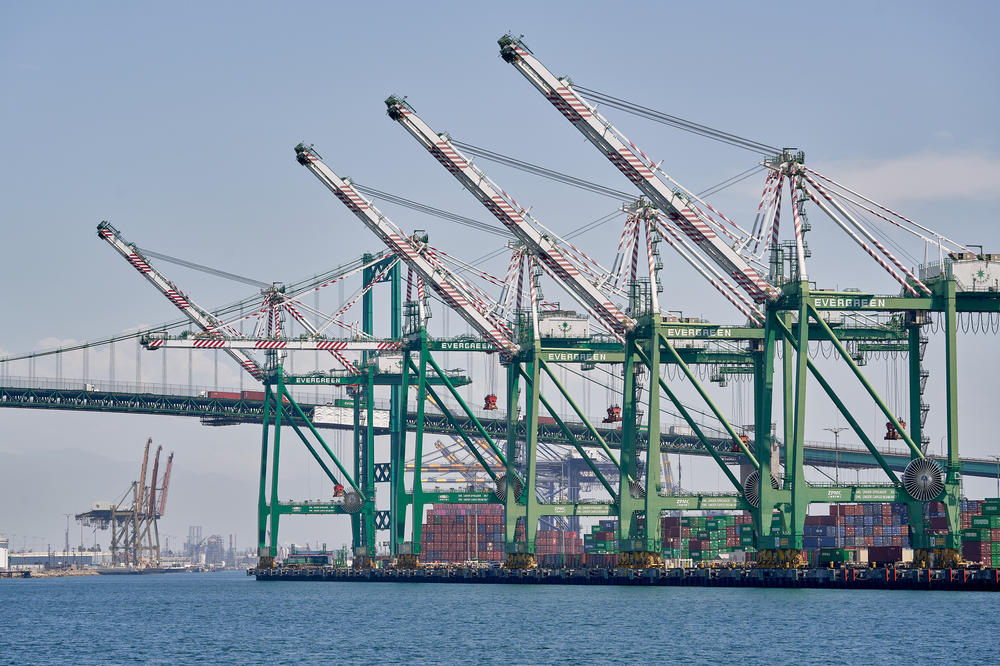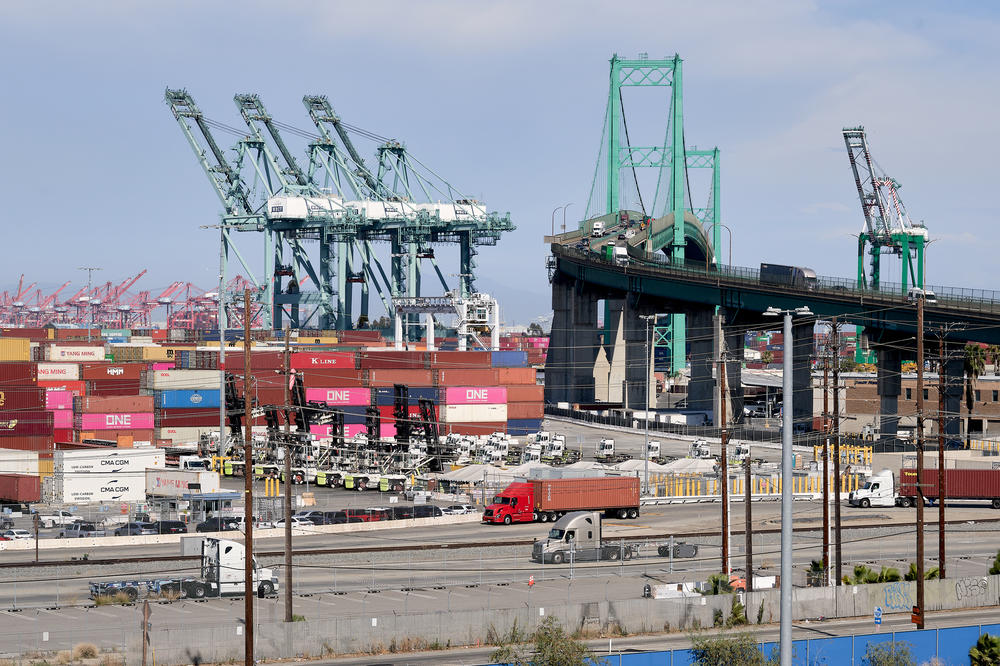Section Branding
Header Content
Before the holiday season, workers at America's busiest ports are fighting the robots
Primary Content
It's a never-ending line of massive ships stacked high with colorful containers that come and go from the ports of Los Angeles and Long Beach these days.
This busy scene is not unexpected as the volume of goods coming across the Pacific Ocean has hit new records during the pandemic.
The shipping industry says it must automate more of the work loading and unloading ships to keep up.
One big goal is to avoid a repeat of last year's supply chain woes as the holidays were nearing. It was a nightmare scene in full display — ships laden with goods bobbing off the coast of Southern California because there were no empty berths and no space on the docks to put any more containers. It was complete gridlock.
But mention automation to dockworkers and it elicits howls of indignation. They say robots are not the answer. They warn automation will only kill American jobs.
In this high-stakes moment at America's busiest ports, robots are a hot-button issue in contract negotiations between the International Longshore and Warehouse Union, which represents 22,000 dockworkers up and down the West Coast, and the Pacific Maritime Association, which represents 70 ocean carriers and terminal operators.
The talks started in May. The last contract expired July 1. The two sides have agreed to no disruption to the work. But in the past, negotiations have devolved into slowdowns and lockouts, bringing trade to a screeching halt. This time around, both sides are well aware that any interruption could wreak economic havoc just as the holiday shopping season gets rolling.
Dockworkers have already seen what automation has meant for jobs
"Every time there's a rumor about a new terminal even contemplating automation, people are scared," says Jimmy Monti, a crane operator with 24 years at the Ports of Los Angeles and Long Beach.
Monti has never worked at an automated terminal. But already, he's seen the impact. Since 2015, driverless vehicles, automated stacking cranes, and other robotics have started to replace truck drivers and forklift operators at several terminals at the port complex.
Yvette Bjazevic, another veteran on the docks who now works in the union dispatch hall, warns that it's not only workers who lose out when jobs go to robots.
"These machines don't contribute to taxes. They don't contribute to the local economy," she says. "I think everyone should be a little outraged."
Even if there are efficiencies to be had with automation, she asks, who's really benefiting? She points out that container shipping is dominated by foreign-owned companies, names like Maersk, Evergreen and China Ocean Shipping. The more goods that come into the U.S., the more profits that go out overseas.
Union-funded research finds significant job loss due to automation
In a union-funded study, the nonprofit research organization Economic Roundtable calculated how much work has been lost at two automated terminals, Long Beach Container Terminal and TraPac.
In what the researchers calls a conservative estimate, the study found that automation eliminated 572 full-time-equivalent jobs annually in 2020 and 2021.
To be clear, no union dockworker was laid off in those years. As part of their contract, ILWU workers have guaranteed base wages, regardless of whether there's work. And because of the recent surge in cargo, there has been plenty of work to go around.
However, the workers who do stand to lose out are the "casual workers," a large contingent of freelancers who take whatever jobs are left once union members have their pick of the work. The casuals are the pipeline for the next generation of union members. They have to work their way up to union membership, a process that already takes years could take longer if the amount of work available on the docks shrinks.
"If this spread to other terminals, it would decimate the labor force, and it would hollow out the economy of the communities around the ports where the dockworkers live," says Daniel Flaming, president of the Economic Roundtable who co-wrote the report. "I think it's a wake-up-and-smell-the-coffee moment."
The shipping industry says automation has increased opportunities for union workers
In its own study, the shipping industry came to the opposite conclusion. It looked at the same automated terminals at the Ports of Los Angeles and Long Beach and found the dockworkers had more work and more opportunities for training and upskilling. (The union counters that the job gains at the automated terminals is a direct result of job losses at the non-automated terminals.)
The shipping industry also says the machines proved their worth at a critical time, processing containers much faster — "at times more than twice as fast," the industry-funded study found.
"We have seen through experience that automated terminals were most effective in handling historic volumes while also expanding work opportunities for ILWU members," said Jim McKenna, CEO of the Pacific Maritime Association, calling it a win-win.
L.A.-area ports are among the least efficient in the world
The need for some kind of change is evident. The Ports of Los Angeles and Long Beach are consistently rated the least efficient in the world. More modern ports in the Middle East and China, where 24/7 operations are the norm, get ships in and out much faster.
Transitioning to a fully-automated operation is extremely costly. Globally, only 53 container terminals, or about 4% of container terminal capacity, is automated "to a certain degree," according to the International Transport Forum. But automation isn't just here, it's expected to grow. One estimate projects that 90% of current dock work could disappear by 2040.
Some union workers have taken jobs at automated terminals while others shun it
As an automation coordinator at the Long Beach Container Terminal, Rebecca Schlarb spends her days in front of six monitors, tracking driverless vehicles and cranes and troubleshooting problems.
"When the system works, it is actually a marvel to watch," says Schlarb, a former marine clerk. But breakdowns are frequent — two or three times a shift, she says. Lost network connections can bring the whole operation to a halt.
Schlarb says many of her union brothers and sisters have turned down work at automated terminals, not wanting anything to do with it.
"For me, it's bittersweet," she says. "I'm a little bit of a geek, so I like the actual work, figuring out how it works. But the amount of jobs that have been lost for both clerks and longshoremen has been so substantial, and that's just a very scary prospect for all of us."
Dockworkers are among the best paid blue collar workers and they support vibrant communities around ports
ILWU dockworkers are among the highest-paid blue collar workers in America. Full-time union members can earn over $100,000 a year. Those with years of experience on the job can earn double that. Health care is free, and pensions are generous.
Those high wages support vibrant communities around the ports. Monti, the crane operator, dreads what could happen to those communities if jobs are lost. He points to Rust Belt cities like Flint, Detroit, and Youngstown.
"You see how those economies were just completely disrupted because the main work source that everybody had vanished," he says.
In Bjazevic's mind, every American should have the opportunity to earn a decent living. Good-paying jobs like those on the waterfront should be the norm, not the exception.
"I'm a hard worker. I'm able to put two kids through college, not worry about a mortgage payment. My husband is sick," she says. "These are the basics."
Copyright 2022 NPR. To see more, visit https://www.npr.org.



